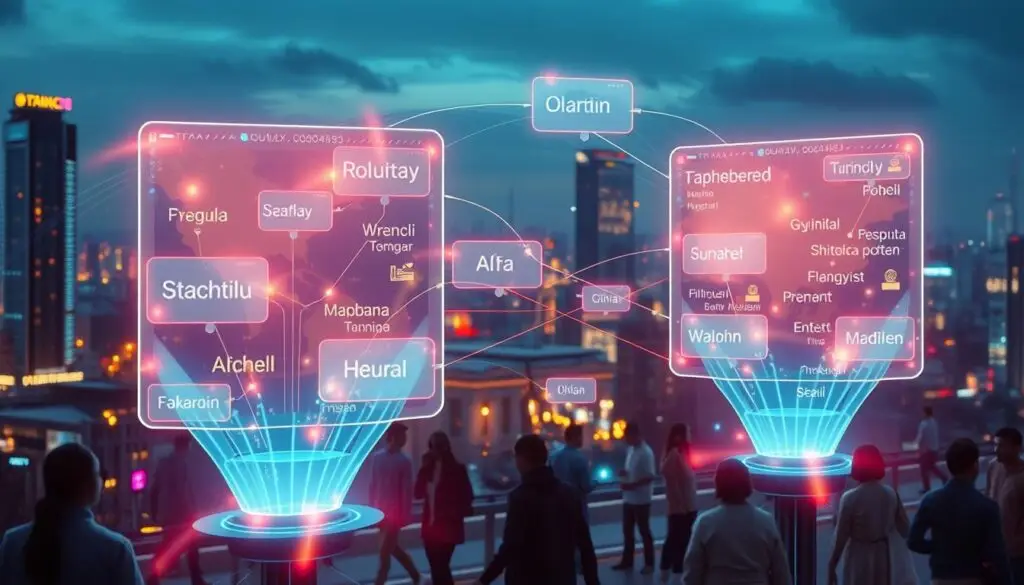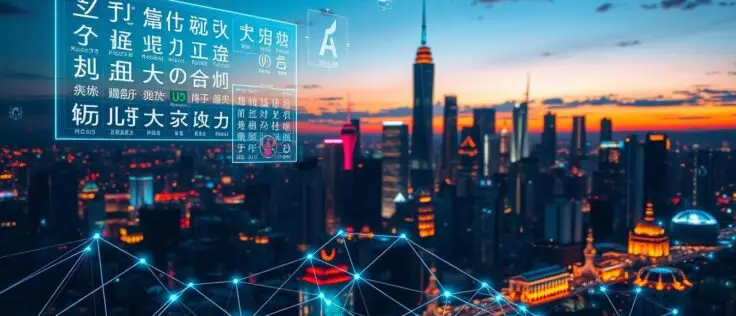Are we at a point where computers get our language better than we do? The world of AI and language translation is quickly changing1. We now see machines translating faster and with more skill than traditional methods. These machines use smart algorithms. They work like our brains and remove language barriers almost like a human would, in both writing and speech2.
Thanks to new tech, tools like Skype Translator and Google’s Pixel Buds make chatting in different languages easy and instant1. These systems are more than translators. They are building a world where we all understand each other, without language getting in the way2.
What future awaits us where talking worldwide is quick and for everyone? How will AI and people work together to face challenges and fully understand each other?
The Impact of AI on Global Language Translation
Advancements in AI have reshaped the world of globalisation, making translation services faster and more reliable. AI doesn’t just change text from one language to another. It bridges cultures, allowing businesses and people to communicate without language barriers.
The translation industry is booming, thanks to AI. It’s expected to grow by 5% each year, reaching a market size of around 77 billion USD by 20253. AI is key for quick and scalable translations. It beats traditional methods by offering faster results and consistent quality across different content4.
Efforts to improve AI in translation are shaping the future of globalisation. AI makes translation processes more efficient. This helps create a world where language unites us, fostering cooperation and understanding across different cultures4.
Unveiling Neural Machine Translation's Role in Language Services
Neural Machine Translation (NMT) is changing the game in language translation. It uses powerful neural networks, making a big difference in how we handle language differences. NMT is more than just a tool—it’s changing the way AI works in translation.
The Advancements of NMT Technology
Neural Machine Translation has made huge strides thanks to deep learning. Technologies like Google’s Transformer model have made NMT a key player in language processing. They provide smooth, natural translations, changing how we tackle complex language patterns and idioms5. NMT’s progress points to even better language services ahead.
NMT and Translation Accuracy Improvements
NMT has dramatically improved translation accuracy. Research shows NMT outperforms older translation systems5. This is crucial for fields like law and healthcare where precision matters. Combining NMT with human experts, as companies like Verbaltrans do, ensures translations are fast, accurate, and culturally relevant5.
Still, perfecting NMT has its hurdles. It struggles with specialized language full of unique terms. Here, human input is vital to make sure translations are both accurate and culturally right. This shows we’ll likely keep using both human skills and neural technology5.
To sum up, as NMT gets better and integrates into more services, it promises more than just translations. It offers precision and cultural insight that were not possible before. These advances mark a new era in how technology overcomes language barriers and boosts global communication65.
Recommended for you:
AI in Language Translation: Breaking Down Cultural Divides
The arrival of AI in language translation has truly bridged major cultural divides. It offers real-time translation and multimodal translation, making cross-cultural communication smoother and more effective. Now, AI-powered chatbots give instant multilingual support. This ensures languages switch smoothly without any stops7.
These AI innovations play a vital role in specific areas like healthcare and e-commerce. They improve global operations and make important information more accessible7. With better privacy and security in AI translation tools, like advanced data encryption, there’s a 25% jump in their use. This shows more people trust and rely on them8.
AI’s smart tech does more than just translate. It enhances how different cultures connect. By picking up on context and personal preferences, AI tools are boosting multimodal translation. They’re starting a new chapter in how we understand and interact, moving beyond old language limits.
Speech Recognition and Realtime Translation: A Boon for Multilingual Communication
The rapid growth of AI tech has greatly improved speech recognition and realtime translation. This progress helps people and companies break language barriers and work together worldwide. With innovations from Meta AI like Seamless M4T V2 and Seamless Expressive, we see that AI translation tools are the future. They understand and replicate human speech nuances accurately.

The Evolution of Speech Recognition in AI Translation Tools
AI tools for speech recognition now have advanced learning that boosts their accuracy and speed. This change reshapes how companies work in different parts of the world, despite language differences. Tools like Seamless M4T offer support for almost 100 languages. They give clear, context-sensitive translations that reflect the speaker’s real meaning and feeling10.
This boost in support for many languages is changing daily chats and improving critical services. In these areas, quick and correct translations can save lives.
Facilitating Cross-cultural Understanding with Realtime Translation
Real-time translation tools are key in overcoming cultural barriers. Tools that mix Speech-to-Text (STT) and Machine Translation (MT), like Seoul’s smart kiosk, offer smooth chats for visitors in 38 languages11. Also, in the workplace, tools like Skype Translator and Samsung’s Galaxy S24 help with real-time communication during international calls and meetings. This ensures smooth and successful international cooperation11.
As AI tech moves forward, it helps achieve the goal of a globally connected society. This society features effortless communication and deep mutual understanding. AI tools’ role in various fields doesn’t just aid realtime translation. It also fosters the inclusion vital for a world rich in languages and cultures.
Empowering Businesses with AI-Powered Multilingual Support
The push towards globalisation means businesses must now provide strong multilingual support. This ensures AI translation tech is key in modern business plans. These technologies help companies communicate globally, making them vital. AI solutions improve business teamwork by offering fast, accurate translations for various languages.
Enhancing International Trade and Collaboration
At the forefront of global trade, AI translation tech lowers barriers that used to limit international business. By using these AI tools, companies see up to 65% more efficiency. This boosts project speed and collaborative work12. Thanks to such advanced tools, businesses can now make sure their deals and daily chats are clear worldwide. This strengthens their global market position.
Smart planning in mergers and acquisitions gets better with AI. These platforms make checking processes smoother and help with following rules and getting accurate values12.
Customer Support Tailored for a Global Audience
AI is changing how businesses serve international customers. By using AI for translation, firms offer instant, precise customer service in many languages. This boosts customer happiness and fosters loyalty. With tools like Unily, which aid global enterprise clients, AI translations work on several texts in different tongues at once. This greatly enhances service speed and customer joy13.
AI systems, like those Unily uses, get better with each use thanks to self-correcting translations. This ongoing improvement is crucial for keeping support high and adapting to language changes in business13.
Language Models and Their Influence on Translation Quality
The growth of language models has hugely changed how translations are done. Now, machine learning pairs with human language nuances to boost translation quality. Tools like OpenAI’s GPT-3 and Google AI’s BERT have reached new highs in creating text and understanding context, greatly bettering translation tool performance14. These steps forward show a big move from old rule-based methods to dynamic, context-knowing models powered by deep learning15.
Neural Machine Translation (NMT) systems rely on deep neural networks. They’re key in providing top-quality translations that grasp grammatical accuracy and cultural context15. This move to NMT marks a significant advance in AI, as systems now match human translators in capturing language nuances. Regular updates with multilingual data from fields like law, medicine, and tech also boost the precision and usefulness of these models14.
Today, language models excel at intricate language tasks, not just straightforward translations. By using various data types, like text, images, and audio, they give richer and more exact translations for different content, such as video and multilingual product descriptions14. AI tools’ adaptability and expansion capacity make translations smoother across many languages. This simplifies global communication14.
Also, integrating ethical considerations into model development tackles biases. This keeps translations fair15. With AI’s progression, it’s essential to include continuous learning. This ensures models stay up-to-date with language trends and adapt to changing human language patterns. Thus, they remain effective in real-time uses and changing settings14.
By using advanced machine learning and handling vast data, language models have become crucial for high-quality translation. The partnership of AI with human checking pushes for better accuracy and efficiency in translations. This improves communications across cultures15.
AI Tools and Their Role in Democratizing Language Learning
As digital platforms improve, AI tools greatly help people worldwide learn languages without old limits. Now, with AI translation tools supporting 95 languages, learners have new levels of access to learning many languages16. These tools customise learning based on the user’s skills and needs, showing how AI personalises online education16.
Moreover, with machine translation in language platforms, learning becomes reachable, efficient, and personalised. AI virtual tutors and chatbots let learners study anytime, which is perfect for busy people or those in different time zones16. This 24/7 availability highlights AI’s role in supporting ongoing learning and skill growth worldwide.
Inclusion is not just about learning alone. AI translation tools are key in removing language blocks in global talks, making sharing across cultures smoother1718. They don’t just swap words; they share contexts, cultural hints, and subtle meanings, important for clear communication in varied places1718.
By making language learning accessible and improving global talks, AI tools and digital platforms are changing global connections. Advances in machine translation mean more people can enjoy the perks of knowing multiple languages, helping to build an inclusive world community18.
Cross-cultural Communication: AI's Contribution to Global Connectivity
The world is getting more connected, and AI is key in improving global talks and cross-cultural connections. Advanced translation aids and AI-powered communication systems are breaking down the language walls in international ties.
Eliminating Language Silos in International Relations
AI tech is vital in destroying language barriers for better global interaction. Real-time translation tools, backed by AI, are crucial in international diplomacy. They prevent mix-ups and ensure clear conversations during important talks.
These tools help not just in diplomacy but also in business and social talks across different languages and cultures. AI’s role shows a big step forward in dealing with linguistic diversity. It makes sure language doesn’t stop international ties. A study with people from more than 20 universities worldwide showed how AI platforms helped improve cross-cultural communication19.
Social Media and AI-Enhanced Language Interactions
Social media uses AI to overcome language barriers. AI-powered translation tools allow instant chats between people who speak different languages. This lets them easily share ideas and cultural values.
AI makes talking on social media easier and boosts global interaction. AI tools in education, like the CILS system, show how AI helps create a connected world19.
Moreover, AI does more than just translate words. It also gets cultural hints, making talks more meaningful. Insights from current laws on AI stress the need for rules to make sure these tools are used right in communication and media19.
In the end, AI is changing global connectivity and international ties in a big way. By getting rid of language barriers and using social media, AI tools are vital in helping the world connect and understand each other better across different cultures.
Natural Language Processing: The Backbone of AI Translation Technologies
Thanks to advanced algorithms, the gap between automated and human translation is getting smaller. This breakthrough allows for smoother interaction between different cultures.
Understanding the Complexities of Human Language
Integrating Sociolinguistic Context into AI Algorithms
In AI translation, mixing NLP with Sociolinguistic Context is crucial for accurately localising content. Immersing AI in human culture lets it translate and culturally adapt texts. Tools like Google Translate and DeepL demonstrate the growth in translation technology. They’re making language a bridge, not a barrier, for global unity20.
FAQ
How is AI transforming the language translation industry?
AI is changing the translation industry in big ways. It uses deep learning and neural machine translation to make translations more accurate and sound natural. These AI services can translate voices in real-time, add subtitles to media, and help people from different cultures communicate easily.
What role does Neural Machine Translation play in language services?
Neural Machine Translation is very important for translating languages. It uses neural networks to make translations that fit the context and are accurate. NMT is better than old methods, making translations more smooth and correct.
Can AI translation tools accurately capture cultural nuances?
AI translation tools are getting better but can still miss cultural details and specific terms. This shows the importance of having human experts check and improve AI translations to make sure they fit the culture and are correct.
How is speech recognition evolving through AI in translation services?
Speech recognition in translation services is growing a lot because of AI. Now, we can translate speech in real-time while keeping the style and emotions. This makes talking in different languages more friendly and exact.
In what ways do real-time translation services benefit international communication?
Real-time translation services are a big help in international talks. They let people speak different languages understand each other right away. This makes business talks and cultural sharing smoother, encouraging global teamwork.
Why is multilingual support essential for businesses in today’s market?
Businesses need multilingual support to serve a global market well. This support ensures they can translate accurately in real-time and offer custom service. It keeps the brand’s image strong and builds relationships with customers around the world.
How do language models influence the quality of AI-driven translations?
Language models, driven by machine learning, are key to AI translations. They learn and adapt to give translations that are more right and full of nuance. This makes AI translations much better.
What is the significance of AI tools in language learning?
AI tools make learning languages easier for everyone using online platforms. They help people and groups get past language barriers in an efficient way.
How does AI contribute to eliminating language barriers in international relations?
AI helps international relations by giving real-time translations that make communication clearer. This reduces misunderstandings and helps in making strong cultural and business links.
In what ways is AI enhancing language interactions on social media?
AI improves language use on social media by translating content. This lets users from different language backgrounds understand and interact with each other. It encourages global connections and more language variety online.
How does Natural Language Processing enhance AI-driven translations?
Natural Language Processing is at the heart of AI’s translation skills. It lets AI understand complex language patterns better. This leads to translations that are more accurate and fitting for the context.
What is the importance of integrating sociolinguistic context into AI translation algorithms?
Putting sociolinguistic context into AI algorithms is crucial. It makes translations that truly reflect cultural differences. This means machine translations are not just right in language but also fit the culture of their audience.
Source Links
- AI and Language Translation: Breaking Down Language Barriers – https://megasisnetwork.medium.com/ai-and-language-translation-breaking-down-language-barriers-47873cfdb13b
- Breaking Language Barriers: Advances in AI-powered Translation Services – https://medium.com/@jam.canda/breaking-language-barriers-advances-in-ai-powered-translation-services-41dc27d85a70
- The Impact of AI on Translation | Argo Translation – https://www.argotrans.com/blog/impact-of-ai-on-translation
- The Impact of AI on Language Translation and Localization – https://braahmaminternational.medium.com/the-impact-of-ai-on-language-translation-and-localization-b8c7808c2201?source=rss——ai-5
- Unveiling the Power and Boundaries of Neural Machine Translation Systems – https://verbaltrans.com/unveiling-the-power-and-boundaries-of-neural-machine-translation-systems/
- Machine Translation vs AI Translation: Unveiling the Future – https://optimational.com/blog/machine-translation-vs-ai-translation/
- AI Enhances Cross-Cultural Language Translation | Newo.ai – https://newo.ai/insights/ai-in-cross-cultural-communication-language-translation/
- AI in Language Translation: Bridging Global Divides – https://medium.com/aimonks/ai-in-language-translation-bridging-global-divides-69409856e136
- AI in Language Translation: Breaking Down Barriers for Global Communication | TW Languages – https://www.twlanguages.com/ai-in-language-translation-breaking-down-barriers-for-global-communication/
- Introducing SeamlessM4T, a Multimodal AI Model for Speech and Text Translations | Meta – https://about.fb.com/news/2023/08/seamlessm4t-ai-translation-model/
- Real-time AI Interpretation: A closer look – Flitto DataLab – https://datalab.flitto.com/en/company/blog/real-time-ai-interpretation-a-closer-look/
- AI for global content – RWS – https://www.rws.com/localization/services/ai-for-global-content/
- How Multilingual AI Is Transforming Internal Comms For Global Workforces – https://www.unily.com/insights/blogs/how-multilingual-ai-is-transforming-internal-comms-for-global-workforces
- The Role of Large Language Models in Machine Translation – https://medium.com/@davidfagb/the-role-of-large-language-models-in-machine-translation-5e1f6eeeb44d
- What’s The Future of AI Translation And Interpretation? – https://waywithwords.net/resource/future-ai-translation-and-interpretation/
- How artificial intelligence is revolutionizing language learning – https://www.berlitz.com/blog/artificial-intelligence-ai-language-learning
- AI for Language Translation: Breaking Down Global Barriers – https://www.linkedin.com/pulse/ai-language-translation-breaking-down-global-barriers-handsonhybrid
- The Rise of AI-Powered Language Translation – TGI – https://www.tabsgi.com/breaking-down-borders-the-rise-of-ai-powered-language-translation/
- Cross-Cultural Intelligent Language Learning System (CILS): Leveraging AI to Facilitate Language Learning Strategies in Cross-Cultural Communication – https://www.mdpi.com/2076-3417/14/13/5651
- Exploring Natural Language Processing (NLP) in Translation – Localize Articles – https://localizejs.com/articles/natural-language-processing-nlp
- Understanding Natural Language Processing: The Backbone of Modern AI – https://medium.com/@brainbucket.ai/understanding-natural-language-processing-the-backbone-of-modern-ai-97a9fbfae294
- Natural Language Processing: The Language of AI – https://profiletree.com/natural-language-processing/






